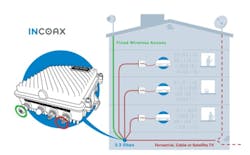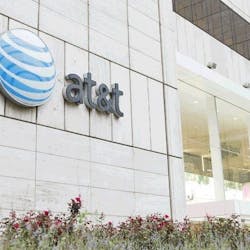Laying fiber to the home or Ethernet cabling from the rooftop for 5G mmWave Fixed Wireless Access (FWA) is not always the most cost-effective option for gigabit or multi-gigabit broadband access. Reusing existing in-building infrastructure, such as coaxial cabling, presents network operators with an uncomplicated and cheaper alternative for broadband connectivity.
A significant obstacle for network operators’ overarching rollout plans has been the provision of consistent gigabit or multigigabit speeds for multi-dwelling units (MDUs), such as apartment complexes, typically in urban areas. In these multi-tenant environments, landlords’ and tenants’ needs continue to climb, with faster connectivity of mission-critical importance. This drives the growth of Fiber Access Extension and 5G mmWave FWA Extension, especially in places where fiber connectivity cannot reach or is too costly to deploy.
Providing fiber and FWA connectivity swiftly and simply to many residencies in an MDU is an essential objective, as building owners may want to avoid significant disruption to tenants, cosmetic damage and noise complaints. As these buildings have existing coaxial cabling or telephone lines, Fiber Access or FWA Extension technologies can prove a more worthwhile proposition. They bring a faster return on investment as network operators can transition DSL customers to fiber or 5G FWA subscribers and prevent additional expenditure on re-cabling property infrastructure.
Finding space for 5G speeds
Multiple customers can share the same 5G FWA modem installed on the rooftop over the air link when using mmWave technology. Currently, for network operators to provide 5G connectivity in MDUs, they must allocate one FWA modem per household or apartment with uncertain connectivity to the base station due to the wall attenuation of the 5G signal.
One alternative is to deploy 5G connectivity from the rooftop to each apartment, and in a large building, this could need tens or hundreds of modems. This will not be possible in more significant MDU buildings due to a lack of rooftop space.
However, it presents the challenge of sourcing adequate space on the rooftop, tackling co-site interference and delivering the necessary radio frequency separation. Even if all of these factors are overcome, the rooftop installation is expensive, increases deployment times and needs a Line of Sight (LoS) to the associated base stations for Ethernet cabling to be laid at each apartment.
Managing attenuation
Typically, the higher frequencies used for mmWave signals struggle to penetrate through walls and as MDUs have multiple walls and experience interference from other signals, this presents a challenge. Similarly, building materials, including brick, concrete, and windows, attenuate (reduce signal strength) and reflect high-frequency signals. The faded signal ultimately provides the end-users with insufficient broadband connectivity.
For network operators to reap gigabit or multi-gigabit services, mmWave technology must be utilized within the 24 – 100 GHz spectrum to reach the service speed criteria.
Therefore, 5G in-door coverage may be uncertain or, sometimes, not a real possibility due to the attenuation experienced. At these higher frequencies, signal strength can be attenuated by as much as 45 dB as it passes through each wall.
5G FWA standards
Earlier this year, global open standards organization Broadband Forum launched a new project (The “Fixed Wireless Access Extension” project from the Wireless Wireline Convergence (WWC) Work Area) focused on providing multi-gigabit speeds and delivering 5G FWA to MDUs. The project also addresses the two critical challenges highlighted above.
It is also primarily focused on reaching apartments and flats within MDUs by harnessing existing property infrastructure, such as twisted pair or coaxial cabling, to extend the FWA connectivity from the attic or basement to all floors.
Network operators have turned to investing more in mobile networks by acquiring spectrum space and more base station infrastructure to unlock the door to more value-added services. Crucially, this project is set to bring network operators more OpEx and CapEx savings and reduced deployment times for end-users with increasingly heightened demands.
Reusing existing cabling
By reusing a building’s existing cabling, a resource prevalent in existing buildings, service providers can continue to grow their market share and beat the competition by using existing infrastructure for fiber and 5G mmWave FWA connectivity.
Harnessing coaxial cabling, typical of all brownfield MDUs, can provide the gift of unfailing broadband services and multi-gigabit data rates in the future.
Helge Tiainen is the head of business development, marketing, and sales at InCoax Networks.






